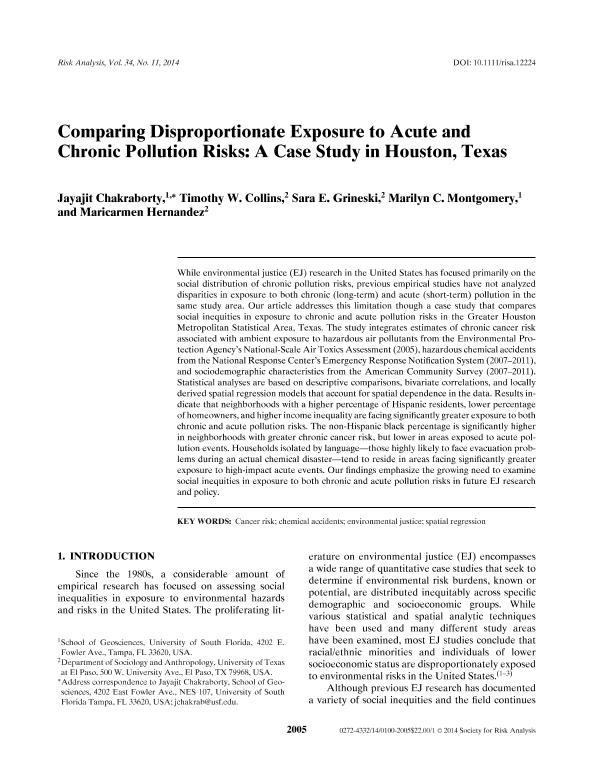Comparing disproportionate exposure to acute and chronic pollution risks : a case study in Houston, Texas

Contenido multimedia no disponible por derechos de autor o por acceso restringido. Contacte con la institución para más información.
| Tag | 1 | 2 | Valor |
|---|---|---|---|
| LDR | 00000cab a2200000 4500 | ||
| 001 | MAP20150006059 | ||
| 003 | MAP | ||
| 005 | 20150216144727.0 | ||
| 008 | 150206e20141103esp|||p |0|||b|spa d | ||
| 040 | $aMAP$bspa$dMAP | ||
| 084 | $a7 | ||
| 100 | 1 | $0MAPA20150006257$aChakraborty, Jayajit | |
| 245 | 1 | 0 | $aComparing disproportionate exposure to acute and chronic pollution risks$b: a case study in Houston, Texas$cChakraborty, Jayajit |
| 520 | $aWhile environmental justice (EJ) research in the United States has focused primarily on the social distribution of chronic pollution risks, previous empirical studies have not analyzed disparities in exposure to both chronic (long-term) and acute (short-term) pollution in the same study area. Our article addresses this limitation though a case study that compares social inequities in exposure to chronic and acute pollution risks in the Greater Houston Metropolitan Statistical Area, Texas. The study integrates estimates of chronic cancer risk associated with ambient exposure to hazardous air pollutants from the Environmental Protection Agency's National-Scale Air Toxics Assessment (2005), hazardous chemical accidents from the National Response Center's Emergency Response Notification System (20072011), and sociodemographic characteristics from the American Community Survey (20072011). Statistical analyses are based on descriptive comparisons, bivariate correlations, and locally derived spatial regression models that account for spatial dependence in the data. Results indicate that neighborhoods with a higher percentage of Hispanic residents, lower percentage of homeowners, and higher income inequality are facing significantly greater exposure to both chronic and acute pollution risks. The non-Hispanic black percentage is significantly higher in neighborhoods with greater chronic cancer risk, but lower in areas exposed to acute pollution events. Households isolated by languagethose highly likely to face evacuation problems during an actual chemical disastertend to reside in areas facing significantly greater exposure to high-impact acute events. Our findings emphasize the growing need to examine social inequities in exposure to both chronic and acute pollution risks in future EJ research and policy | ||
| 650 | 4 | $0MAPA20080565176$aContaminación | |
| 650 | 4 | $0MAPA20080562434$aExposiciones | |
| 650 | 4 | $0MAPA20080545260$aRiesgos | |
| 650 | 4 | $0MAPA20080610425$aEmisiones contaminantes | |
| 650 | 4 | $0MAPA20080588953$aAnálisis de riesgos | |
| 650 | 4 | $0MAPA20080562236$aEnfermedades | |
| 651 | 1 | $0MAPA20080638337$aEstados Unidos | |
| 773 | 0 | $wMAP20077000345$tRisk analysis : an international journal$dMcLean, Virginia : Society for Risk Analysis, 1987-2015$x0272-4332$g03/11/2014 Volumen 34 Número 11 - noviembre 2014 , p. 2005-2020 |

